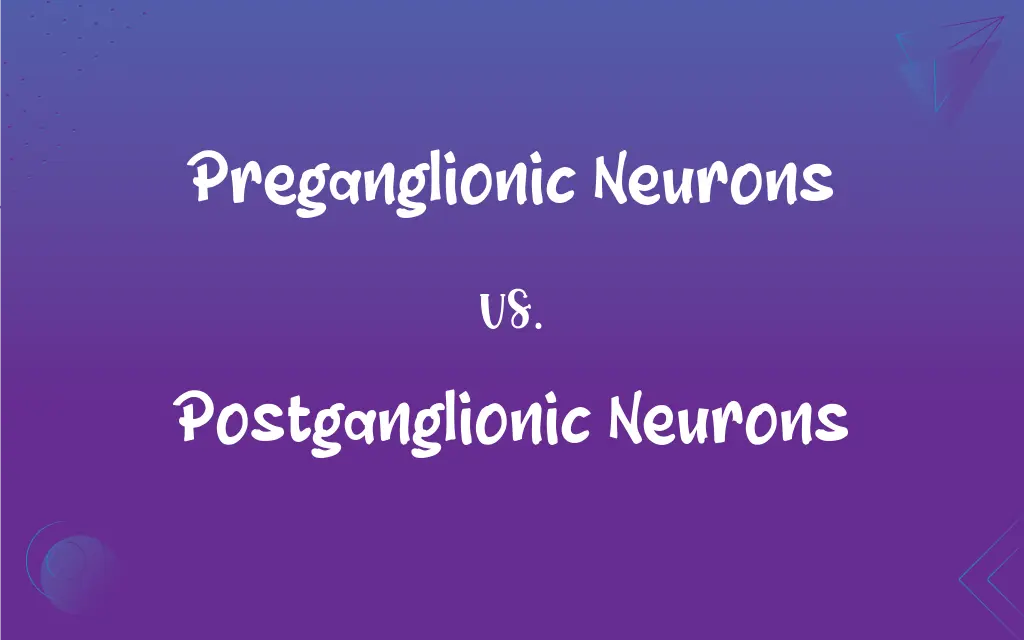Preganglionic Neurons vs. Postganglionic Neurons: What's the Difference?
By Janet White & Harlon Moss || Published on March 3, 2024
Preganglionic neurons originate in the central nervous system and connect to postganglionic neurons in autonomic ganglia, while postganglionic neurons extend from the ganglia to effector organs, mediating responses.

Key Differences
Preganglionic neurons are the first neurons in the autonomic nervous system's two-neuron chain, extending from the central nervous system (CNS) to an autonomic ganglion. They release neurotransmitters, typically acetylcholine, which activate postganglionic neurons. Postganglionic neurons, in contrast, carry signals from the autonomic ganglia to the target tissues or organs, such as muscles or glands, and usually release neurotransmitters like norepinephrine or acetylcholine to elicit specific responses.
The cell bodies of preganglionic neurons are located in the spinal cord or brain, forming part of the pathway that transmits signals from the CNS to the body's periphery. Postganglionic neurons have their cell bodies in the autonomic ganglia outside the CNS and complete the pathway by transmitting signals to the effector organs. This structural difference underscores their distinct roles in the autonomic nervous system's operation.
Preganglionic neurons are typically myelinated, resulting in faster signal transmission, whereas postganglionic neurons are usually unmyelinated, leading to slower signal propagation. This difference in myelination reflects their functional roles and the need for precise, rapid transmission of signals from the CNS.
The length of preganglionic and postganglionic fibers varies between the sympathetic and parasympathetic divisions of the autonomic nervous system. In the sympathetic division, preganglionic fibers are shorter because the ganglia are closer to the spinal cord, whereas in the parasympathetic division, preganglionic fibers are longer, with ganglia located near or within the target organs, affecting the speed and specificity of autonomic responses.
Both types of neurons are integral to the autonomic nervous system's function, which controls involuntary physiological processes. Preganglionic neurons initiate the response to internal or external stimuli, while postganglionic neurons execute the response, highlighting the collaborative nature of neural pathways in maintaining homeostasis.
ADVERTISEMENT
Comparison Chart
Origin
Central nervous system (CNS)
Autonomic ganglia outside the CNS
Target
Autonomic ganglia
Effector organs (e.g., glands, smooth muscles)
Neurotransmitter
Primarily acetylcholine
Acetylcholine or norepinephrine, depending on division
Myelination
Typically myelinated
Usually unmyelinated
Fiber Length
Varies, shorter in sympathetic division
Varies, longer in parasympathetic division to reach distant organs
ADVERTISEMENT
Preganglionic Neurons and Postganglionic Neurons Definitions
Preganglionic Neurons
Have shorter fibers in the sympathetic division.
Shorter preganglionic fibers quickly connect to the sympathetic chain ganglia.
Postganglionic Neurons
Usually unmyelinated, resulting in slower signal transmission.
The slower transmission in postganglionic neurons allows for precise control over organ responses.
Preganglionic Neurons
Neurons that transmit signals from the CNS to autonomic ganglia.
Preganglionic neurons in the sympathetic system rapidly activate stress responses.
Postganglionic Neurons
Release norepinephrine or acetylcholine, depending on their function.
Norepinephrine from postganglionic neurons increases heart rate during stress.
Preganglionic Neurons
Part of the autonomic nervous system's two-neuron chain.
Preganglionic neurons are the first step in autonomic signaling to organs.
Postganglionic Neurons
Have longer fibers in the parasympathetic division.
Long postganglionic fibers in the parasympathetic system reach the distant digestive organs.
Preganglionic Neurons
Typically myelinated for faster signal transmission.
The myelination of preganglionic fibers aids in swift stress reaction.
Postganglionic Neurons
Neurons that carry signals from ganglia to effector organs.
Postganglionic neurons regulate heart rate by controlling cardiac muscle contraction.
Preganglionic Neurons
Primarily release acetylcholine as a neurotransmitter.
Acetylcholine released by preganglionic neurons activates postganglionic neurons.
Postganglionic Neurons
Execute the final response in autonomic pathways.
Postganglionic neurons directly trigger gland secretion or muscle contraction.
FAQs
What neurotransmitters are associated with postganglionic neurons?
Postganglionic neurons primarily release norepinephrine in the sympathetic division and acetylcholine in the parasympathetic division.
What role do preganglionic and postganglionic neurons play in the autonomic nervous system?
They form a two-neuron chain that mediates involuntary physiological processes, with preganglionic neurons initiating the response and postganglionic neurons executing the final action on effector organs.
What distinguishes preganglionic neurons from postganglionic neurons?
Preganglionic neurons originate in the CNS and signal to autonomic ganglia, while postganglionic neurons relay signals from ganglia to effector organs.
How do the lengths of preganglionic and postganglionic fibers differ between the sympathetic and parasympathetic divisions?
In the sympathetic division, preganglionic fibers are shorter due to closer ganglia, while in the parasympathetic division, preganglionic fibers are longer, with ganglia near or within target organs.
Can preganglionic neurons stimulate multiple postganglionic neurons?
Yes, a single preganglionic neuron can branch and stimulate multiple postganglionic neurons, allowing for a broad distribution of the autonomic response.
What determines the neurotransmitter released by postganglionic neurons?
The division of the autonomic nervous system (sympathetic or parasympathetic) and the specific target tissue determine whether a postganglionic neuron releases norepinephrine or acetylcholine.
Are there exceptions to the neurotransmitters released by preganglionic and postganglionic neurons?
While most preganglionic neurons release acetylcholine and sympathetic postganglionic neurons release norepinephrine, there are exceptions, such as sympathetic postganglionic neurons innervating sweat glands releasing acetylcholine.
Why are preganglionic neurons myelinated?
Preganglionic neurons are myelinated to ensure fast and efficient transmission of electrical signals from the CNS to the autonomic ganglia.
What happens if the communication between preganglionic and postganglionic neurons is disrupted?
Disruption in communication can lead to impaired autonomic functions, affecting heart rate, digestion, blood pressure regulation, and other involuntary processes.
Do preganglionic and postganglionic neurons regenerate after injury?
Neurons have limited regeneration capacity; however, some peripheral nerves, including postganglionic fibers, can regenerate under certain conditions, though recovery may not be complete.
How do preganglionic and postganglionic neurons contribute to the fight-or-flight response?
In the fight-or-flight response, preganglionic neurons of the sympathetic system activate postganglionic neurons, which then release norepinephrine to prepare the body for rapid action.
What is the significance of the varicosities in postganglionic neurons?
Varicosities are swellings along postganglionic neurons that release neurotransmitters along the length of the neuron, ensuring diffuse and widespread effects on target tissues.
How does the nervous system ensure precise control over organ systems with these neurons?
The nervous system modulates the activity of preganglionic and postganglionic neurons through various neurotransmitters and receptors, allowing for precise control over the intensity and duration of responses in target organs.
What research is being conducted on preganglionic and postganglionic neurons?
Research focuses on understanding their roles in disease, potential for regeneration, and how their function can be modulated in conditions like hypertension, heart disease, and neurological disorders.
How does aging affect the function of preganglionic and postganglionic neurons?
Aging can lead to changes in neurotransmitter levels and receptor sensitivity, potentially altering the efficacy of autonomic responses mediated by these neurons.
About Author
Written by
Janet WhiteJanet White has been an esteemed writer and blogger for Difference Wiki. Holding a Master's degree in Science and Medical Journalism from the prestigious Boston University, she has consistently demonstrated her expertise and passion for her field. When she's not immersed in her work, Janet relishes her time exercising, delving into a good book, and cherishing moments with friends and family.
Co-written by
Harlon MossHarlon is a seasoned quality moderator and accomplished content writer for Difference Wiki. An alumnus of the prestigious University of California, he earned his degree in Computer Science. Leveraging his academic background, Harlon brings a meticulous and informed perspective to his work, ensuring content accuracy and excellence.































































